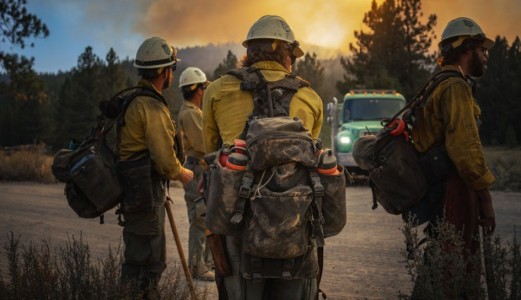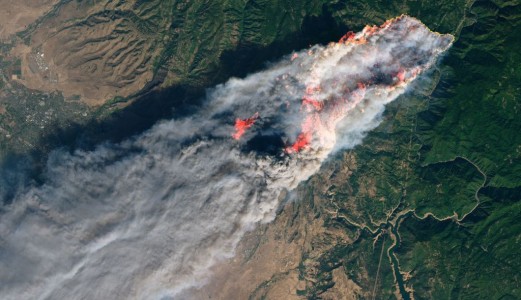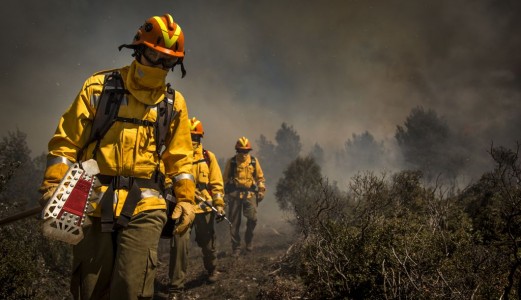Data versus information
In the analysis of fire behaviour, there is a lot of potentially available data. We can study fire line intensity in kilowatts per metre (kW/m) or lifting condensation level (LCL) in metres, which would tell us at what height the smoke plume will start to condense. However, such data, while valuable for further study and analysis, does not provide practical information for wildland firefighters on fire lines.
In order to understand and predict fire spread, it is essential to understand fire dynamics and its response to fire spread factors. These factors are evaluated using variables that characterise fire behaviour, providing valuable information to determine what strategy, tactics, and operations to use in each situation.

What do fire behaviour variables tell us?
Fire behaviour variables are objective and quantifiable measurements of a fire front. These variables allow us:
- To be accurate when transmitting information about the fire behaviour that is developing.
- Calculate our suppression capacity in the different parts of the fire.
What behaviour variables are relevant in a wildfire?
In wildland fires, the behaviour variables that provide valuable information are:
- Flame length: This indicates flame intensity.
- Rate Of Spread (ROS): Indicates the rate at which the flames are spreading.
- The dynamics of secondary spot fires: This provides information on the presence, number and distance of secondary spot fires.
If we are capable of analysing fire behaviour and relating it to the factors that influence fire behaviour, we will be able to analyse and predict how the fire will evolve.
In the previous Wildfire Lesson we talked about the "Toolbox". Now that you know all the possibilities we have and how we can combine them, let's see how they relate to behaviour variables.
Flame length
To assess control and suppression capacity of the flames, it is necessary to calculate the energy released by the fire front. Calculating the flames length in metres gives us an approximate idea of the energy released and whether or not we will be able to suppress them. It also provides information on which tool is suitable for suppression and whether a direct attack or a combination of several tools and combined operations are required.
For example, when facing flames of approximately 1-1.5 metres, we can use the Alaska fire swatter alongside a full set of protective equipment. However, if the flame length exceeds 2 metres, a combined operation involving the 20-litre VFT PRO backpack pump will be required. The operation would consist of several water discharges from the backpack with the intention of reducing the flame length and, following this, the fire swatter to completely suppress the flames. In more extreme cases, with a flame length of 3-4 metres, we would need an aircraft to drop water further ahead and then attack the flames with the backpack and fire swatter. As you can see, depending on the flame length, we can tackle flames with the use of one or a combination of several tools.
It is important to note that, in order to measure the flames length, one should take half of the base of the flame width and draw a straight line to its apex. Flame length should not be confused with flame height, as flames can be very slanted and have a long length, but not much height.


Rate of spread
Secondly, when analysing fire behaviour, we must consider the rate of spread, which determines the rate at which the fire progresses. This speed is calculated linearly and provides us with the time required for the fire to travel a certain distance. In essence, it is a relationship between the distance travelled and the time taken.
Although it is possible to use measurements of area per time unit, such as hectares per hour, in practice it is usually more convenient to calculate it in metres per hour or kilometres per hour.
Let us assume that a front is spreading at 400 metres per hour in a fixed direction. If we create a hand line using a combination of several Gorguis, the approximate rate at which we will progress will be about 300 metres per hour. In this scenario, if we work flanking the fire, we would not be able to catch up with the fire head until it slows down. However, by combining hand tools with hose line, we can increase our rate of suppression, since hand tools can be used for rapid stabilisation and the hose line suppresses and mops up the flames, achieving a rate of progress of 500 metres per hour.
If the suppression rate exceeds the rate of spread, strategies implemented are effective. If not, a combination of tools or re-evaluation of the operation is required. The term "Suppression Ratio" is derived from this relationship, which will be further discussed in a forthcoming Wildfire Lessons article.
It is essential to note that the working rates with different tools given above are an approximation, as these depend on the type of terrain, vegetation, the physical condition of the firefighters, their experience and other factors that may have an influence.
Secondary spot fire dynamics
A secondary spot fire is a new ignition source that is generated outside the fire's perimeter, either due to an ember or the release of incandescent material into the smoke plume.
In this context, it is crucial to know the number of secondary spot fires and their distance in metres or even kilometres. It is also relevant to know in which part of the fire they might occur, as they are not limited exclusively to the fire head. Generally, secondary spot fires will follow the same behaviour as the fire that started them, so their presence must be considered in terms of safety for the crew.
In this secondary spot fire dynamic, the Tactical Unit 2 together with the suppression kit and the Heliskid are an indispensable resource. Their ability to carry water, together with the ease to access inaccessible areas, enables secondary spot fire outbreaks to be controlled quickly and effectively before they grow and behave as an independent fire or merge with the main one.
Effectiveness, efficiency and safety: Key not only in our tools, but also in our operations.
In summary, when working with wildland fires, it is necessary to acquire a broad vision to interpret the relevant data. This will allow us to understand what the wildfire is doing and what it can do in each situation. We focus on operational variables that are objective, quantifiable and universal. In addition, it is essential to know the capacities of our tools and to understand that the right combination of tools can increase our suppression capacity.
Effectiveness, efficiency, and safety must be key elements in our operations. Knowledge of behaviour variables and the availability of appropriate tools enable us to make decisions that consider these three fundamental aspects.







